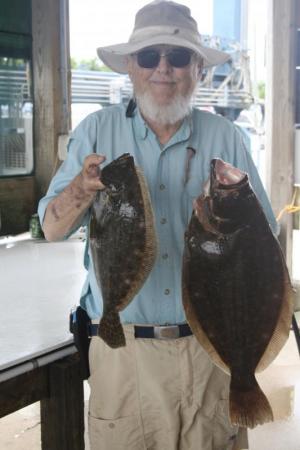While the winter has been mild, I am pretty sick of it, and I am anxious for some warm weather and the first good fishing days. As noted in previous columns, 2018 was not a good year for me and I am hoping for much better luck in 2019.
In order to change my luck, I am going to change my fishing operation. I am going to spend more time on the water. Even when conditions are not ideal, I am going to be out there giving it a try.
I don’t mean I will be fishing in bad weather, but I will be going when the tides and winds are not perfect. I am going to take my own advice and find places to fish no matter the conditions. Looking back on 2018, the one place I did have some luck was Indian River Inlet. Sure, I only caught hickory shad and small blues, but at least I caught something. I have been fishing the inlet since the 1940s, so I sort of take it for granted, but in 2019, I am going to be there more often.
The same is true for Indian River Bay. My eyes were opened by the flounder tournament there last year when a 16-year-old kid won with a five-pounder. I am going back there to check out all my old hot spots and perhaps find some new ones.
Ocean City, Md., produced better flounder fishing than we had anywhere in Delaware during 2018. I have no idea why, but the reports were consistently better from the inlet to the Route 90 bridge than from anywhere in Indian River or Rehoboth Bay.
I would like to try to catch some of the sheepshead around the South Jetty at the Ocean City Inlet. Once again, they seem to be there in good numbers and yet not so much at Indian River Inlet.
It would be nice if the big blues returned to Delaware in 2019. They made a poor showing in 2018 compared to the previous years, and it would be great to see them in 2019 in the surf and from the fishing pier at Cape Henlopen State Park.
And then we have the sea trout or weakfish. There were a few larger fish in 2018, but, of course, nothing anywhere near the glory days we had from the 1970s into the early 1990s. The people at Fish and Wildlife do surveys of the young-of-the-year and find good reproduction, but what happens to those fish from the time they depart the Delaware Bay every fall until they should return the next spring remains a mystery.
In 2019, I did manage to catch some decent spot, but my croaker catches were definitely down in size and numbers. Both species are fast-growing, and I hope to see more and larger ones in 2019.
Finally we have flounder in Delaware. I had one good day in the Lewes-Rehoboth Canal, catching a five-pounder and a 17-incher. I hope to put in more time there and try some new lures and rigs. My flounder fishing in the ocean will depend on the kindness of friends with boats larger than my 16-footer.
Cobia and mako fishing regs
There will be new regulations for cobia in Delaware for 2019. The National Marine Fisheries Service has turned over cobia management to the Atlantic States Marine Fisheries Commission because most of the cobia caught are taken in state waters. Delaware has started the regulatory procedure, but it is a slow process and will take some time before the new regulations are brought to public hearings.
Delaware will be a de minimis state, which means we don’t land enough cobia to show up on their chart. As such, we will have two options. The first is the default de minimis option from the Cobia Fishery Management Plan: One cobia per angler or vessel per day or trip, whichever is longer, with a minimum size of 32 inches. The second option is the regulation from the nearest non-de minimis state, which is Virginia. We would have an open season from June 1 to Sept. 15. One cobia per day per angler or three cobia per vessel per day with a 40-inch minimum size.
Shark fishermen will see a change in the size limit for short-fin makos. The minimum size for males will be 71 inches fork length while females will have a minimum fork length of 83 inches.
Anyone who has ever handled a mako at boatside will tell you they don’t behave very well. Trying to determine the sex of a thrashing fish with a mouth full of nasty teeth will pose a challenge.

























































